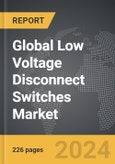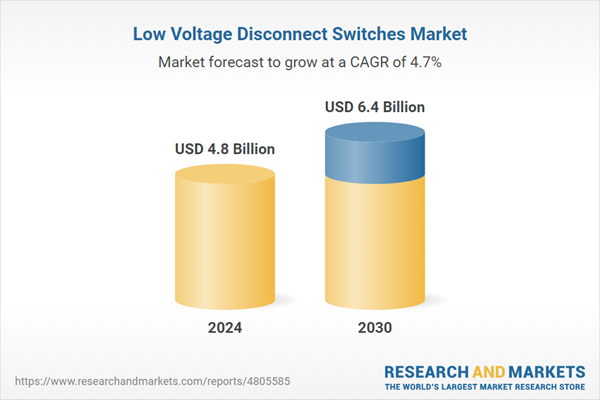Global Low Voltage Disconnect Switches Market - Key Trends & Drivers Summarized
What Are The Cutting-Edge Technological Innovations Shaping Low Voltage Disconnect Switches?
The evolution of low voltage disconnect switches is being driven by state-of-the-art innovations in sensor integration, microprocessor control, and solid-state electronics that are redefining reliability and response times in critical applications. Manufacturers are incorporating advanced semiconductor devices, including MOSFETs and IGBTs, to achieve rapid switching operations and precise control under variable load conditions. Digital control modules now enable real-time monitoring of voltage levels, while sophisticated algorithms and embedded firmware provide predictive diagnostics and self-calibration features that minimize downtime. Novel insulation materials and compact form factors have allowed designers to create devices that withstand environmental extremes and electromagnetic interference, ensuring operational integrity even in challenging industrial settings. In addition, developments in power management integrated circuits (PMICs) are fostering lower energy consumption and higher thermal efficiency, which are essential in applications ranging from battery management to renewable energy integration. Enhanced connectivity through IoT platforms is enabling remote control and monitoring, thus allowing maintenance teams to respond to potential faults before they result in system failures. The integration of wireless communications and cloud-based data analytics provides granular insights into performance trends and supports dynamic system optimization. Research efforts have also led to miniaturization without compromising on safety features, paving the way for low voltage disconnect switches that are not only smarter but also more adaptable to modern, decentralized power systems. Digital simulation and modeling tools have further refined design parameters, ensuring that the final products deliver precise disconnect functions at the lowest possible voltage thresholds. This technological convergence is setting a new benchmark in the design and reliability of disconnect systems that form the backbone of modern low voltage distribution networks, while simultaneously reducing system costs and environmental impact.How Are Evolving End-Use Applications Expanding The Horizons of Low Voltage Disconnect Switches?
Low voltage disconnect switches are finding an ever-expanding role across a multitude of end-use applications, driven by the need for enhanced safety, operational efficiency, and system automation. In renewable energy systems, these switches are critical for protecting battery arrays and solar inverters from over-discharge, ensuring that energy storage components are maintained within optimal operational ranges. Industrial automation applications leverage these devices to protect sensitive equipment from voltage fluctuations, thereby maintaining continuity in manufacturing processes and reducing unplanned downtime. In the automotive and electric mobility sectors, disconnect switches are increasingly integrated into battery management systems, where their rapid response to voltage drops is vital for vehicle safety and performance. Infrastructure projects, particularly in smart grid deployments, rely on these switches to dynamically isolate faulted circuits and maintain uninterrupted power distribution in densely interconnected urban environments. In data centers and communication networks, where even minimal power instability can result in significant financial losses, low voltage disconnect switches safeguard critical loads and help maintain system redundancy. Their use in residential and commercial building systems - especially in energy-efficient smart homes - underscores the growing demand for devices that combine performance with enhanced user safety and reduced maintenance requirements. The customization of disconnect switches for specific operational profiles, including adaptations for high humidity, corrosive environments, or rapid cycling applications, further broadens their applicability. This diversification of end-use applications is fueling market growth by ensuring that low voltage disconnect switches meet the precise requirements of each industry segment, thereby supporting the development of resilient and energy-efficient electrical infrastructures.What Shifting Consumer Behavior And Market Dynamics Are Influencing The Adoption Of Low Voltage Disconnect Switches?
Market dynamics for low voltage disconnect switches are being profoundly influenced by shifting consumer behavior, regulatory imperatives, and an overarching demand for smart, connected infrastructure. End users are increasingly prioritizing devices that not only deliver high performance but also provide real-time diagnostics and remote management capabilities - features that are now possible thanks to advanced sensor technologies and integrated communication modules. The demand for sustainable and energy-efficient solutions is driving the adoption of disconnect switches that reduce energy wastage and improve system reliability, with consumers seeking certifications and compliance with international safety standards. Government policies and energy regulations that mandate strict performance and safety benchmarks have accelerated the replacement of legacy systems with modern, digitally enhanced alternatives. Additionally, the rise of smart grids and distributed energy resources is creating an ecosystem where interoperability and system intelligence are crucial, prompting manufacturers to incorporate IoT connectivity and cloud-based analytics into their designs. This trend is further reinforced by an increased focus on lifecycle cost analysis, with buyers opting for solutions that offer lower long-term operational expenses and enhanced durability. The convergence of digital transformation initiatives and consumer demand for environmentally responsible products has also led to a surge in investments in research and development, resulting in continuous product innovation and improved market competitiveness. Digital marketplaces and transparent product evaluation platforms are empowering consumers to compare performance metrics and make informed decisions, thereby driving market momentum. Overall, these market dynamics are creating a competitive landscape where innovation, quality, and sustainability converge to redefine the role of disconnect switches in modern electrical systems.The Growth In The Low Voltage Disconnect Switches Market Is Driven By Several Factors…
The growth in the low voltage disconnect switches market is driven by several factors, including transformative technological enhancements in semiconductor design, power management, and digital control systems. End-use trends such as the rapid expansion of renewable energy installations, smart grid developments, and advanced battery management in electric vehicles are directly fueling demand, as each application requires precise voltage regulation and fault isolation. Consumer behavior shifts toward integrated, remote-monitoring solutions are compelling industries to adopt systems that offer real-time diagnostics and predictive maintenance capabilities. Regulatory requirements emphasizing energy conservation, environmental protection, and safety compliance are also key drivers, as industries seek to mitigate risks associated with electrical system failures. Advances in digital integration, including the use of IoT sensors and cloud-based analytics, are enabling more effective lifecycle management and lowering total cost of ownership for end-users. Increased R&D investments, strategic partnerships between component suppliers and system integrators, and the growing need for miniaturized, robust designs are collectively accelerating market innovation. Furthermore, the integration of advanced materials that enhance thermal management and electromagnetic compatibility is making these devices more versatile and reliable. Digital simulation tools and improved manufacturing processes have reduced production costs and enhanced quality, thereby expanding the addressable market globally. These technological, end-use, and consumer-driven factors, combined with supportive regulatory frameworks and market-oriented innovation strategies, are driving the sustained expansion of the low voltage disconnect switches market.Report Scope
The report analyzes the Low Voltage Disconnect Switches market, presented in terms of units. The analysis covers the key segments and geographic regions outlined below.Segments: Type (Fused, Non-Fused); Application (Industrial, Commercial).
Geographic Regions/Countries: World; United States; Canada; Japan; China; Europe (France; Germany; Italy; United Kingdom; and Rest of Europe); Asia-Pacific; Rest of World.
Key Insights:
- Market Growth: Understand the significant growth trajectory of the Fused segment, which is expected to reach US$3.8 Billion by 2030 with a CAGR of a 4.3%. The Non-Fused segment is also set to grow at 5.3% CAGR over the analysis period.
- Regional Analysis: Gain insights into the U.S. market, valued at $1.3 Billion in 2024, and China, forecasted to grow at an impressive 4.4% CAGR to reach $1.0 Billion by 2030. Discover growth trends in other key regions, including Japan, Canada, Germany, and the Asia-Pacific.
Why You Should Buy This Report:
- Detailed Market Analysis: Access a thorough analysis of the Global Low Voltage Disconnect Switches Market, covering all major geographic regions and market segments.
- Competitive Insights: Get an overview of the competitive landscape, including the market presence of major players across different geographies.
- Future Trends and Drivers: Understand the key trends and drivers shaping the future of the Global Low Voltage Disconnect Switches Market.
- Actionable Insights: Benefit from actionable insights that can help you identify new revenue opportunities and make strategic business decisions.
Key Questions Answered:
- How is the Global Low Voltage Disconnect Switches Market expected to evolve by 2030?
- What are the main drivers and restraints affecting the market?
- Which market segments will grow the most over the forecast period?
- How will market shares for different regions and segments change by 2030?
- Who are the leading players in the market, and what are their prospects?
Report Features:
- Comprehensive Market Data: Independent analysis of annual sales and market forecasts in US$ Million from 2024 to 2030.
- In-Depth Regional Analysis: Detailed insights into key markets, including the U.S., China, Japan, Canada, Europe, Asia-Pacific, Latin America, Middle East, and Africa.
- Company Profiles: Coverage of players such as ABB Ltd., Addison Electric, Inc., Alfanar Group, Benedict GmbH, Black Box Network Services and more.
- Complimentary Updates: Receive free report updates for one year to keep you informed of the latest market developments.
Some of the 48 companies featured in this Low Voltage Disconnect Switches market report include:
- ABB Ltd.
- Addison Electric, Inc.
- Alfanar Group
- Benedict GmbH
- Black Box Network Services
- Blue Sea Systems
- Canadian Energy
- China Delixi Group Co., Ltd.
- Eaton Corporation Plc
- Elcodis Company Ltd.
Tariff Impact Analysis: Key Insights for 2025
Global tariff negotiations across 180+ countries are reshaping supply chains, costs, and competitiveness. This report reflects the latest developments as of April 2025 and incorporates forward-looking insights into the market outlook.The analysts continuously track trade developments worldwide, drawing insights from leading global economists and over 200 industry and policy institutions, including think tanks, trade organizations, and national economic advisory bodies. This intelligence is integrated into forecasting models to provide timely, data-driven analysis of emerging risks and opportunities.
What’s Included in This Edition:
- Tariff-adjusted market forecasts by region and segment
- Analysis of cost and supply chain implications by sourcing and trade exposure
- Strategic insights into geographic shifts
Buyers receive a free July 2025 update with:
- Finalized tariff impacts and new trade agreement effects
- Updated projections reflecting global sourcing and cost shifts
- Expanded country-specific coverage across the industry
Table of Contents
Companies Mentioned (Partial List)
A selection of companies mentioned in this report includes, but is not limited to:
- ABB Ltd.
- Addison Electric, Inc.
- Alfanar Group
- Benedict GmbH
- Black Box Network Services
- Blue Sea Systems
- Canadian Energy
- China Delixi Group Co., Ltd.
- Eaton Corporation Plc
- Elcodis Company Ltd.
Table Information
| Report Attribute | Details |
|---|---|
| No. of Pages | 226 |
| Published | April 2025 |
| Forecast Period | 2024 - 2030 |
| Estimated Market Value ( USD | $ 4.8 Billion |
| Forecasted Market Value ( USD | $ 6.4 Billion |
| Compound Annual Growth Rate | 4.7% |
| Regions Covered | Global |









